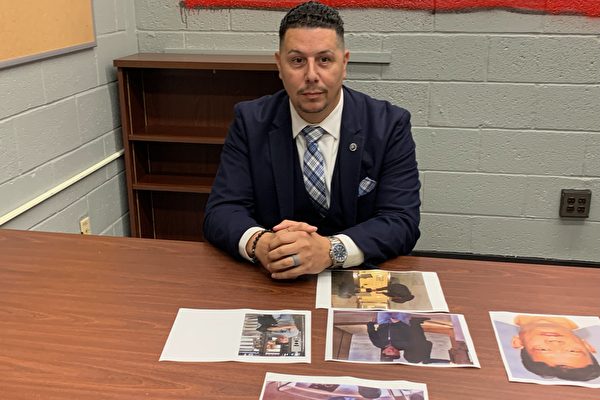A Chinese jewelry thief who sneaked into the United States at the end of last year, managed to successfully steal valuables worth tens of thousands of dollars from high-end jewelry stores in New York, Long Island, California, and Florida through a series of elaborate heists that seemed like magic tricks. However, his streak of success came to an end when he was finally caught. On May 24, Detective Scott Gomez of the Major Crimes Unit of the New York City Police Department, who was handling the case, revealed the tactics of this “seasoned” international thief and how law enforcement managed to track and ultimately apprehend him at his residence in Flushing on the 40th Road.
The suspect, 49-year-old Yaorong Wan, allegedly stole jewelry worth hundreds of thousands of dollars after illegally entering the country in December last year and seeking asylum. He was released and went on to commit a series of crimes across the United States, with a total of over $620,000 involved in the cases. He has been charged with grand larceny in the second degree for the thefts he committed in Manhattan.
Detective Gomez explained that Wan was a skilled “professional criminal” whose cunning tactics involved diverting the attention of store employees by engaging them in conversation while swiftly swapping items. An example of Wan’s modus operandi was seen on March 4 when he targeted the Tiffany & Co. jewelry store at the Rockefeller Center in Manhattan.
Upon entering the store, Wan approached an Asian employee, initially speaking English before inquiring if the employee spoke Mandarin. He claimed to be a buyer from China interested in purchasing diamond rings. Wan asked to see several rings of varying sizes, starting with a two-carat ring, then a 2.5-carat one, and finally a 3.3-carat ring valued at $255,000. While engaging the employee in conversation and making eye contact to distract them, Wan managed to conceal the ring in his right hand when the employee turned to fetch another ring.
Subsequently, he deftly switched the genuine ring with a similar-looking but fake one without the employee’s notice. Wan informed the employee that he needed to step out to make a phone call to the buyer, promising to communicate the buyer’s decision later. However, he never returned after leaving the store. The theft of the 3.3-carat ring was only discovered during a routine inventory check on the weekend, revealing that the ring was fake and lacked a serial number.
Following the distribution of images and videos of Wan’s thefts to the Jewelry Security Alliance, which has over 2,000 member jewelry stores, law enforcement swiftly received a call from the luxury jewelry chain Cartier reporting his visits to their stores on January 16 in Beverly Hills, March 12 in Hudson Yards in New York City, and in Miami on March 24. Additionally, Wan stole a watch worth $12,000 in Nassau County, Long Island on April 19.
In one instance on March 12 at a Cartier store in Hudson Yards, Wan asked to try on two watches and rings. While the employee was distracted, Wan managed to steal a $25,000 ring of similar size without detection. Detective Gomez highlighted Wan’s ability to divert the employee’s attention towards his eyes, expertly concealing items by not placing them in his pocket but rather at the bottom of his hand. By requesting to inspect multiple items simultaneously, Wan exploited the employees’ focus on making sales, allowing him to steal items effortlessly.
So, how was Wan eventually caught? Gomez revealed that law enforcement utilized facial recognition technology after obtaining surveillance footage from jewelry stores to identify him and track his whereabouts. Collaborating with border enforcement agencies, authorities confirmed Wan’s illegal entry into the country using fake names and identity documents. Investigations revealed that Wan had no legitimate employment and sustained himself by selling stolen items. Tracing back to the address Wan provided upon entry in Queens, New York, law enforcement conducted surveillance on him.
The New York City Police Department worked in conjunction with Nassau County law enforcement to locate Wan’s vehicle and conduct surveillance until enough evidence was gathered to obtain a search warrant for his residence. During the search operation, stolen watches and a fake ring resembling the one used at Tiffany & Co. were recovered.
After Wan’s arrest by the New York authorities, he was released, only to be apprehended by Nassau County Police with a bail set at $500,000. He is currently in custody. Further investigations by Long Island authorities revealed Wan’s alleged involvement in a $320,000 jewelry theft in South Korea on September 30, 2018. A red notice and arrest warrant issued by Interpol for Wan remain valid.
Gomez emphasized that investigations are ongoing and the focus is on recovering the stolen items. Anyone found in possession of the stolen goods or aware of their origins will face charges. Authorities are urging individuals to exercise caution when purchasing items from these individuals.
Gomez mentioned that there are six unresolved jewelry cases with an estimated total value of $6 million. Law enforcement believes Wan may have committed more thefts that have yet to be discovered, and they hope to identify more victims and recover stolen items through media exposure.
To prevent similar thefts at jewelry stores, Gomez recommended that owners and employees only display one expensive item at a time when assisting customers and ensure the prompt retrieval of items after each showing. High-quality surveillance camera systems should be installed in stores and periodic inventory checks conducted. In case of a missing item, immediate reporting to law enforcement is advised over conducting internal investigations to provide authorities with more time and leads to recover the stolen items. If any suspicious activity is observed, such as individuals selling high-value items at low prices, it should be reported promptly to the authorities.

